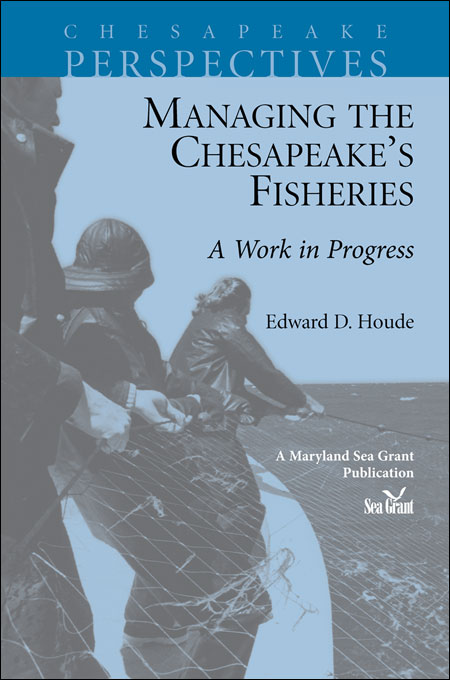Knauss legislative fellowships in Congress help build careers — and they're fun and educational. See our video and fact sheet for details.
Oyster Farmers Get a Leg Up in the Business
Maryland Sea Grant Extension Helps Shellfish Growers Produce Oyster Seed
James Pitcher grabs a rope dangling off his wooden dock and hauls up a cage filled with dripping oysters. The shellfish are growing in knotty clumps, and they’re getting big.
"This is a lot of last year's. They're nice," says Pitcher, a long-time waterman from Maryland's Calvert County. "They're more than an inch. Some of them are closer to two inches."
Pitcher's dock juts out from Broomes Island, a small spit of land on the Patuxent River a few miles north of the town of Solomons. It's a steamy August day, and the waterman is sweating. He usually harvests crabs from the river around this time of year, but he says that he hasn't been out in his boat for several days because of the heat. "I'm getting too old,” he says.
He may not be crabbing, but Pitcher is still working the water. He's one of a growing number of Marylanders who have turned to oyster farming, or aquaculture, as a business. The shellfish he pulled up this day are from his first generation under cultivation, and he's working on his second now. Pitcher is excited about this new venture, too. He says that aquaculture will give him and his three adult children, who are also his business partners, new opportunities to earn a living.
The waterman is learning about aquaculture through a project called the Remote Setting Training program. It’s run jointly by the Oyster Recovery Partnership, a non-profit group based in Annapolis; the University of Maryland Center for Environmental Science Horn Point Hatchery, which supplies oyster larvae; and University of Maryland Extension, which provides training support.
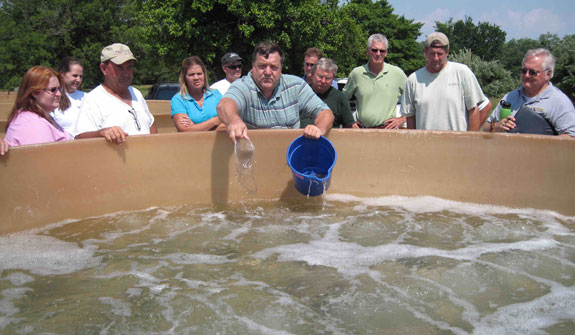 |
| Extension Shellfish Aquaculture Specialist Donald Meritt (center) demonstrates remote setting techniques to shellfish growers from around Maryland in classes like the one shown here at the University of Maryland Center for Environmental Science Horn Point Laboratory. Credit: Maryland Sea Grant Extension |
The goal is to help men and women like Pitcher to clear some of the hurdles that face oyster farmers new to the business, in this case by training them how to produce the young oysters that will grow into larger shellfish like the ones hanging off of Pitcher's dock. The program is part of a larger statewide effort to encourage watermen who have traditionally harvested oysters in the wild to consider careers in aquaculture.
When it comes to aquaculture, "I think a lot of [watermen] are realizing that it gives them a good alternative," says Donald Webster, a specialist at the Maryland Sea Grant Extension Program. Webster provides training as part of a team that also includes Donald Meritt, who is a Maryland Sea Grant Extension specialist and director of the Horn Point Hatchery.
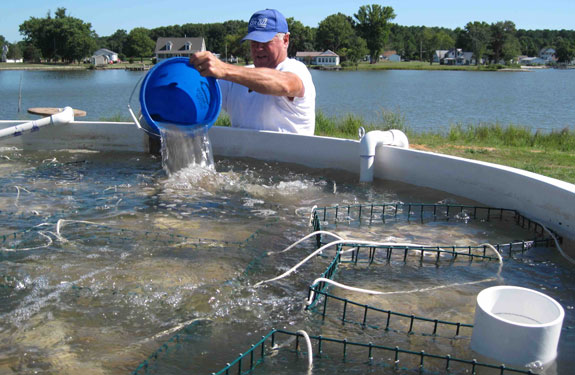 |
| One waterman who's trying aquaculture is Robert T. Brown, president of the Maryland Watermen’s Association. He has eight setting tanks at Colton’s Point in St. Mary’s County. He not only produces seed for his own oyster-aquaculture leases, but he also sells spat-on-shell to the state for planting on public harvest bars. Credit: Maryland Sea Grant Extension |
Setting Spat
Alan Roache and Steven Weschler know a lot about those alternatives. Both men are faculty research assistants at the Horn Point Oyster Hatchery. And today they’ve driven down to Broomes Island to talk with James Pitcher about his new aquaculture business. The men have also come to inspect the contents of two tanks stored on his property. Each tank is the size of an above-ground swimming pool. They’re filled with Patuxent River water and packed to the brim with oyster shells — more than 100,000 of them, Weschler estimates.
These tubs are called setting tanks. They’re used to make spat, or young oysters that have attached themselves onto a hard surface, usually an old piece of shell. Spat are a crucial ingredient in any aquaculture operation: oyster farmers rely on these young shellfish to seed their aquaculture leases, much like traditional farmers sow their fields.
Making your own spat, however, isn’t easy, Webster says: it takes some engineering skill to build a setting system and some biological know-how about the conditions that young oysters need to survive. Oyster growers can buy spat-on-shell directly from hatcheries on the Bay, but that can get pricey and requires hauling hundreds of pounds of shells over long distances.
It’s these challenges that the Remote Setting Training (RST) program was designed to address. In 2014, the program operated 32 setting tanks at nine sites located across the Bay, including these two on Pitcher’s property. The program is running the same number in 2015. Maryland oyster growers can reserve the equipment for two-week periods from June to August, time enough to produce — with help from Roache and Weschler — their supplies of oyster seed.
The program was initially funded by the U.S. National Oceanic and Atmospheric Administration and supported by the Maryland Department of Natural Resources.
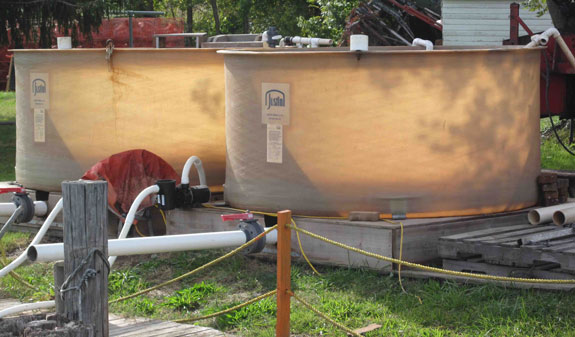 |
|
Maryland Sea Grant Extension’s Remote Setting Training program provides tank systems like these in nine locations around Maryland’s Chesapeake Bay, including this one at Shady Side in Anne Arundel County. Each tank is eight feet wide and four feet deep and holds about 1,500 gallons. The tank holds about 300 half-bushel shell bags and should produce approximately one million spat-on-shell. Credit: Maryland Sea Grant Extension |
That process of making spat began before today. A week earlier, Roache and Weschler made an initial trip to Broomes Island bringing packets of oyster larvae produced at the Horn Point hatchery. Donald Meritt, the hatchery's director, introduced the process of remote setting to the state in the early 1980s.
Each batch of larvae came in dark, grainy clumps packed loosely in coffee filters that each held 2.5 million young oysters. With Pitcher's help, the team stirred these clumps into a bucket of water, then splashed the resulting mix into the shell tanks. Over several days, the larvae swam through the water, finally gluing themselves onto the shells.
Today, the hatchery biologists are back to make sure that the process has gone off without a hitch. That means counting the number of glued-down spat on a random sample of shells. "If we can get five per shell, we're happy with that," Weschler says. "It's all over the place. Sometimes it's five per shell. Sometimes it's 25 per shell.”
Once the biologists finish their counting, Pitcher will empty these tanks and take the new spat to his aquaculture lease site, located nearby on the Patuxent. The research assistants, however, emphasize that the program isn’t a handout. Roache and Weschler aren’t just helping Pitcher to produce his spat, they’re also teaching him how to complete the process on his own — and how to understand the biology of oysters in the process. The goal, in other words, is for the participants to become self-sufficient.
Or, as Roache put it, the goal is to have participants say “Okay, we’ve got this. We can roll with it.”
It seems to be working: in 2015, 40 oyster growers took part in the Remote Setting Training program. Since the program began in 2011, aquaculture entrepreneurs in Maryland, many of them graduates of the program, have built their own, customized setting systems like the one on Broomes Island.
For now, James Pitcher is enjoying learning about his new business. He says that he likes to watch the oysters hanging off of his dock as they eat, opening their shells to siphon in the surrounding river water. This biofiltration is important not only to oyster growth but also to the health of the Chesapeake Bay. “Those things amaze me,” he says.
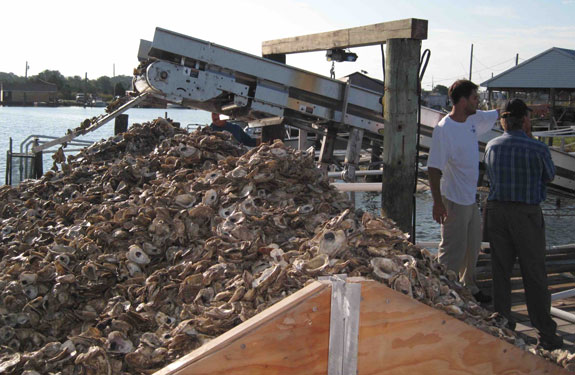 |
| This boat was built by Metompkin Shellfish in Crisfield to plant oyster spat-on-shell created through remote setting. The conveyor loads the boat with spat-on-shell obtained from remote setting tanks located at the dock. Credit: Maryland Sea Grant Extension |
Photo, top left: Shellfish growers involved in remote setting operations in Maryland watch oyster larvae being prepared for placement in a setting tank. Credit: Maryland Sea Grant Extension
For further information about oyster aquaculture and remote setting, visit the webpages of the Maryland Sea Grant Extension Program and University of Maryland Extension.
See contact information for the Extension Program’s aquaculture specialists.
See all posts from the On the Bay blog




